Introduction
When it comes to driving traffic to your website, many people focus on content and SEO. While these are essential, there’s another critical factor that often goes unnoticed—User Experience (UX) and User Interface (UI) design. A visually appealing, intuitive, and user-friendly website not only keeps visitors engaged but also encourages them to return, share your site, and improve your SEO rankings. In this blog, we’ll explore how can we use UX/UI design to increase website traffic directly and share actionable tips to optimize your site.

What is UX/UI Design?
UX (User Experience) design is about creating a seamless and enjoyable journey for users as they interact with your website. It focuses on functionality, ease of navigation, and meeting user needs.
UI (User Interface) design, on the other hand, deals with the aesthetic elements of the website, such as layout, colors, typography, and interactive elements. Together, UX/UI form the backbone of a website’s design and usability.
How UX/UI Design Impacts Website Traffic
1. Improves First Impressions
Your website’s design is often the first interaction a visitor has with your brand. Research shows that users form an opinion about a website within 50 milliseconds. A professional and aesthetically pleasing design encourages users to stay, while a cluttered or outdated design may lead them to bounce.
Tip: Use clean layouts, professional color schemes, and modern fonts to create a strong first impression.
2. Enhances Navigation and Usability
A website with intuitive navigation ensures users can quickly find what they’re looking for. Poor navigation frustrates users, causing them to leave and reducing your site’s dwell time—a key SEO metric.
Tip: Implement clear menu structures, breadcrumb trails, and search functionalities to simplify navigation.
3. Boosts Engagement and Dwell Time
An engaging and user-friendly design keeps visitors on your site longer, signaling to search engines that your content is valuable. Longer dwell time positively impacts your SEO rankings, making your website more discoverable.
Tip: Add interactive elements like videos, infographics, and engaging call-to-action (CTA) buttons.

4. Reduces Bounce Rates
Bounce rate refers to the percentage of visitors who leave your website after viewing only one page. A poor UX/UI design—slow loading times, broken links, or unresponsive elements—can increase bounce rates, negatively impacting your SEO performance.
Tip: Optimize loading speeds and ensure your website is mobile-friendly.
5. Supports Mobile Responsiveness
With over 50% of global website traffic coming from mobile devices, having a responsive design is no longer optional. A mobile-friendly site ensures a consistent experience across all devices, attracting more users.
Tip: Use responsive web design techniques and test your site on multiple devices.
6. Improves SEO Rankings
Google and other search engines prioritize user-friendly websites. Key UX/UI metrics like page speed, mobile usability, and dwell time directly affect your SEO rankings.
Tip: Use tools like Google PageSpeed Insights to monitor and improve your website’s performance.
Key UX/UI Design Principles to Increase Website Traffic
1. Prioritize Simplicity
Simplicity is the ultimate sophistication. Avoid overwhelming users with too many design elements.
- Use plenty of white space.
- Keep the layout clean and intuitive.
2. Focus on Visual Hierarchy
Guide users’ attention to important elements like CTAs and headlines using size, color, and placement.
- Use contrasting colors for CTAs.
- Highlight key sections with bold typography.
3. Optimize for Accessibility
An accessible website ensures everyone, including people with disabilities, can navigate and use it effectively.
- Use alt text for images.
- Ensure sufficient color contrast for readability.
4. Conduct Regular Testing
Regular usability testing helps identify bottlenecks in your design that could drive visitors away.
- Use heatmaps to track user behavior.
- Conduct A/B testing for design changes.
Success Stories: UX/UI Driving Traffic
Case Study: Jadeed.store
Our team at Hastech revamped the UX/UI design of Jadeed.store within their limited budget, focusing on user-friendly navigation, faster loading speeds, and a visually appealing interface. These changes led to:
- A 40% reduction in bounce rate.
- A 25% increase in repeat visitors.
- A significant improvement in SEO rankings.
Tools to Help You Optimize UX/UI
- Adobe XD: For creating wireframes and prototypes.
- Google Analytics: To track user behavior and engagement.
- Hotjar: For heatmaps and user feedback.
- PageSpeed Insights: To monitor and improve site performance.
Conclusion
Investing in UX/UI design is more than just making your website look good; it’s about creating an environment where users feel engaged, valued, and encouraged to interact. By improving first impressions, enhancing usability, and supporting SEO efforts, a well-designed website can significantly boost your traffic and help your business thrive.
Ready to take your website to the next level?
Contact Hastech for professional UX/UI design services tailored to your business needs.




